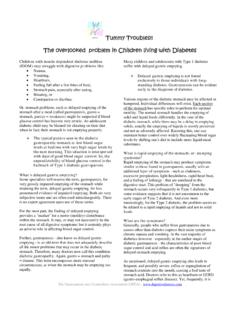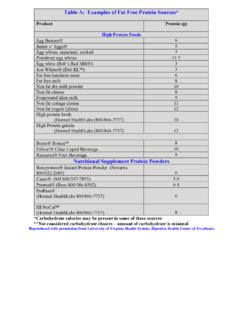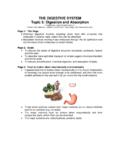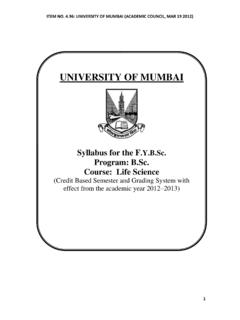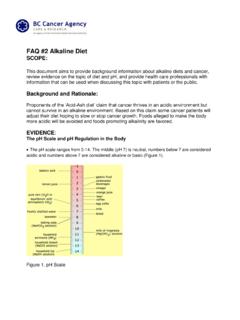Transcription of Gas Bloating - Digestive Distress
1 Gastroparesis & Dysmotilities Association This pamphlet is one in a series discussing symptoms and symptom management for patients living with Digestive Motility sMission is to provide accurate information to patients; increase awareness to the public and medical community about Digestive Motility Diseases; and facilitate the search for a cureGPDA: 5520 Dalhart Hill NWCalgary, ABT3A 1S9 Telephone: (403) 247-3215E-mail: Remington , MS39042 Telephone: (601) 824-0338E-mail: GPDA Printed 01/06 GasBloatingBelchingWhen these symptoms are ChallengingAltered or abnormal Motility (Dysmotility)Many diseases of the Digestive tract can alter motility and when this occurs, symptoms result. Rapid motility may result in diarrhea. Spasms or unsynchronized motility may result in painful cramps. Increased visceral (gut) sensitivity is not a problem of altered motility, but reflects abnormal sensitivity within the Digestive tract s nervous system and be one cause for the sensation of pain.
2 Weakened motility or paralyzed motility represents Digestive four main types of Digestive Motility Diseases are:Gastroparesis (GP): is the most common. Gastro means stomach and paresis means weakness. It frequently is found in association with dysmotilities of the esophagus and the small Intestinal Pseudo-obstruction (CIP): Is the Digestive motility disease that primarily affects the small intestines, but is frequently found in association with Gastroparesis and may progress to complete Digestive Inertia: the motility disease that primarily affects the large intestine, and may progress to CIP and : is the Digestive motility disease that affects the esophagus What is Digestive Motility?The Digestive tract is a long, hollow, muscular organ which processes your food. This processing action; churning, kneading, mixing with Digestive juices, and synchronized waves of propulsion, is called Motility. Digestive Motility Diseases are a group of Digestive diseases that share characteristics of weak to paralyzed motility.
3 Any region of the Digestive tract can be affected and each region has its own diagnostic label. They are primarily diseases of the enteric nervous system and/or muscles within the Digestive tract. Enteric is the medical term that refers to the gut. Weakened motility means food and secretions do not move. Instead, they pool and just sit, or are vomited back up. This group of Digestive diseases may mimic a bowel obstruction, hence are often called functional obstructions or pseudo-obstructions. There is no obstruction to be found, but the obstructive symptoms are the result of faltering motility. These Diseases or Disorders?This group of Digestive diseases has also been called: Gastrointestinal ( Digestive ) Motility Disorders. However, individuals who are severely affected show cellular abnormalities on full-thickness biopsies. Therefore, disease is a more accurate we can make a difference. Please support GPDA-USA__ $25 __$50 __$100 Other: $_____I prefer to donate on-line using a major credit :_____Address:_____Postal Code/ Zip:_____E-mail address:_____Phone number:_____I understand that all my information will be kept confidential and not made available to any other send me more information about:_____Membership.
4 _____Volunteering my skills and time to in honor of a loved one to our Quest for a Cure fund. Yes! I want to support GPDA, is my tax-deductible donation:Pleases make cheques/checks payable to GPDA, for Canada; or GPDA-USA, for Americans. Send your cheque/check and this form to the address on the registered charity number: 859541310RR001 When Gas, Bloating and Belching are more than a nuisance. _____Symptoms? Everyone has suffered from the effects of too much gas, but forpatients with motility problems, these symptoms can be enormously challenging and painful. They go beyond just a nuisance problem and may instead interfere with everyday is responsible for the symptoms of belching and Bloating . Gas will follow the path of least resistance and rise upwards. When excess amounts accumulate in the stomach, usually from swallowed air, then pressure is felt.
5 Contractions of the abdominal muscles help to forcibly expel the gas through the valve at the top of the stomach up the esophagus and out through the mouth. This valve is called the Lower Esophageal Sphincter or LES. Individuals with upper Digestive motility problems usually suffer with a great deal of acid reflux and / or regurgitation (please see our pamphlet on Gastro-esophageal Reflux Disease) created by the pooling of contents not moving along the Digestive tract. To control excess refluxing, a surgical procedure may be performed to convert the two way valve of the LES into a one way value. This procedure, called a fundoplication and usually effectively controls refluxing, however; it can also prevent belching and vomiting. A resulting gas bloat can be a painful problem post fundoplication. Gas may normally accumulate within the small intestine or colon. It is easily moved along by normal motility, and everyone has experienced embarrassing, odorous social encounters.
6 But, when motility is sluggish, as in Digestive motility problems, then gas accumulates within the loops of the small intestine, resulting in sensations of Bloating and even visible distention. The belly can swell-up causing the skin to stretch and become painful to touch. Pants have to be undone or loosened because of the expanded, tender abdomen. 1 Gas is Motility and Gas. Everyone swallows some air and everyone produces gas as a by-product of the teeming bacteria which happily co-exist in our large intestine (colon). The amount of gas that an individual produces varies depending upon diet and types of bacteria in the gut from approximately to 2 liters every day. Compromised Digestive motility compounds the management of normal amounts of gas creating painful motility in the upper Digestive region will cause problems even with normal amounts of swallowed air during a meal. As well, loops of the small intestine can become filled with air, which does not move along.
7 Instead it may continue to accumulate, distending the abdomen. These air filled loops will even show-up on an abdominal x-ray. This sluggish motility can also cause bacteria to proliferate throughout the small intestine and even into the stomach. These abnormally increased populations of bacteria in the upper Digestive region produce high amounts of gas (hydrogen or methane) leading to pronounced abdominal distention, pain and belching, along with problems of digestion. To learn more about Small Bowel Bacterial Overgrowth (SBBO), please see our pamphlet on this the lower Digestive tract, slowed motility can cause problems of stool accumulation throughout the colon, or in severe situations, stool impaction. This impaction can create an intermittent blockage that allows gas to accumulate causing distention, Bloating , pain and other obstructive Motility and Ntn Iae ro teaioalItt hnsitues ofHealt2 Gas and Abdominal abdominal painSplenic-flexure syndrome Too much Digestion of digestion of sugars:Some individuals can develop Gastroparesis after an intestinal infection.
8 What may compound their Gastroparetic symptoms is the additional problem of poor sugar digestion. Abnormalities of motility are thought to be associated with abnormal sensitivity. This increased sensitivity to normal volumes of gas may result in pain. For some who suffer with (pain that has no known cause), it is believed that abnormal motility and sensitivity may be the source of a chronic abdominal pain disorder triggered by trapped gas at the left flexure (bend) of the large colon. This flexure is located where the large colon runs horizontally then bends downwards towards the rectum. This bend occurs near the spleen--hence the name splenic flexure. Trapped gas in this location can cause pain to be felt in the chest region. Called referred pain, since the pain is felt in a region distant from the source, it can mimic heart disease. Gas trapped in the right flexure can mimic pain of gall bladder disease or appendicitis.
9 Can result from chronic inflammation in the lining of the small intestine. Even in an acute inflammation, caused from common infections like:- Bacterial food poisoning,- Viral infections of the gut (gastroenteritis or stomach flu ),- Parasitic infections of the gut, example Giardia, or create a lingering problem of poor sugar the small intestine the villi or, finger like protrusions provide the necessary surface area for absorbing nutrients and digestion of food sugars (lactose, fructose and sorbital). Acute inflammation mows down these villi and may take as long a 6 months to heal post gastroenteritis before your body is once again adequately able to digest an hour or two after eating the offending carbohydrate, symptoms may occur of: Belching, Bloating , Nausea Smelly gas (flatulence), Abdominal cramps, and Loose stools or watery Hydrogen Breath Test is commonly used to test for specific sugars that may be creating these symptoms.
10 This test consists of drinking a carbohydrate. Then samples of expired air are collected over two hours. Individuals with delayed stomach emptying (Gastroparesis) and small bowel dysmotilities may take longer to complete this test. A blood test is also available. --Lactose: The sugar found in milk and milk products. Yogurt however is not a problem since the lactose has already been broken down by the bacterial culture used to ferment the : The sugar found in fruits, onions, and artichokes--Sorbitol: Used as an artificial sweetener, but also found in prunes, pears, peaches and : Starches found in whole grains, bran or wheat cereals can cause major bouts of Bloating and gas. The starch in white rice is well tolerated and causes the least : is a complex carbohydrate found in beans, cabbage, brussels sprouts, broccoli, asparagus and other vegetables as well as some whole individual may be sensitive only to one particular sugar like Lactose and digest the other sugars without difficulty.
